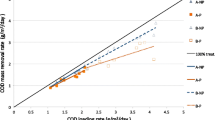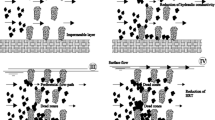Abstract
Clogging is the main operational problem associated with horizontal subsurface flow constructed wetlands (HSSF CWs). The measurement of saturated hydraulic conductivity has proven to be a suitable technique to assess clogging within HSSF CWs. The vertical and horizontal distribution of hydraulic conductivity was assessed in two full-scale HSSF CWs by using two different in situ permeameter methods (falling head (FH) and constant head (CH) methods). Horizontal hydraulic conductivity profiles showed that both methods are correlated by a power function (FH = CH0.7821, r 2 = 0.76) within the recorded range of hydraulic conductivities (0–70 m/day). However, the FH method provided lower values of hydraulic conductivity than the CH method (one to three times lower). Despite discrepancies between the magnitudes of reported readings, the relative distribution of clogging obtained via both methods was similar. Therefore, both methods are useful when exploring the general distribution of clogging and, specially, the assessment of clogged areas originated from preferential flow paths within full-scale HSSF CWs. Discrepancy between methods (either in magnitude and pattern) aroused from the vertical hydraulic conductivity profiles under highly clogged conditions. It is believed this can be attributed to procedural differences between the methods, such as the method of permeameter insertion (twisting versus hammering). Results from both methods suggest that clogging develops along the shortest distance between water input and output. Results also evidence that the design and maintenance of inlet distributors and outlet collectors appear to have a great influence on the pattern of clogging, and hence the asset lifetime of HSSF CWs.










Similar content being viewed by others
References
Bowmer, K. H. (1987). Nutrient removal from effluents by artificial wetland: influence of rhizosphere aeration and preferential flow studied using bromide and dye tracers. Water Research, 21(5), 591–599.
Brix, H. (1997). Do macrophytes play a role in constructed treatment wetlands? Water Science and Technology, 35(5), 11–17.
Carter, M. R., & Ball, B. C. (1993). Soil porosity. In M. R. Carter (Ed.), Soil sampling and methods of analysis (pp. 581–588). Boca Raton: CRC.
Caselles-Osorio, A., Puigagut, J., Segú, E., Vaello, N., Granés, F., García, D., et al. (2007). Solids accumulation in six full-scale subsurface flow constructed wetlands. Water Research, 41(6), 1388–1398.
Cooper, P., & What can we learn from old wetlands? (2009). Lessons that have been learned and some that may have been forgotten over the past 20 years. Desalination, 246, 11–26.
Cooper, D. J., Griffin, P., & Cooper, P. F. (2005). Factors affecting the longevity of subsurface horizontal flow systems operating as tertiary treatment for sewage effluent. Water Science and Technology, 51(9), 127–135.
Elrick, D. E., & Reynolds, W. D. (1992). Methods of analyzing constant-head well permeameter data. Soil Science Society of American Journal, 56, 320–323.
Elrick, D. E., Angulo-Jaramillo, R., Fallow, D. J., Reynolds, W. D., & Parkin, G. W. (2002). Analysis of infiltration under constant head and falling head conditions. In P. A. C. Raats et al. (Eds.), Environmental mechanics: water, mass and energy transfer in the biosphere. Geophysical Monograph; Series, vol. 129 (pp. 47–53). Washington, DC: AGU.
García, J., Caselles-Osorio, A., Story, A., De Pauw, N., & Vanrolleghem, P. A. (2007). Impact of prior physico-chemical treatment on the clogging process of subsurface-flow constructed wetlands: model-based evaluation. Water, Air, and Soil Pollution, 185, 101–109.
Griffin, P., Wilson, L., & Cooper, D. (2008). Changes in the use, operation and design of sub-srface flow constructed wetlands in a major UK water utility. 11th International Conference on Wetland Systems for Water Pollution Control. Indore, India, 419–426.
Kadlec, R. H., & Wallace, S. D. (2009). Treatment Wetlands (2nd ed.). Boca Raton: CRC Press.
Knowles, P. R., & Davies, P. A. (2009). A method for the in-situ determination of the hydraulic conductivity of gravels as used in constructed wetlands for wastewater treatment. Desalination and Water Treatment, 1(5), 257–266.
Knowles, P. R., Griffin, P., & Davies, P. A. (2010). Complementary methods to investigate the development of clogging within a horizontal sub-surface flow tertiary treatment wetland. Water Research, 44, 320–330.
Knowles, P., Dotro, G., Nivala, J., & García, J. (2011). Clogging in subsurface-flow treatment wetlands: occurrence and contributing factors. Ecological Engineering, 37(2), 99–112.
Langergraber, G., Haberl, R., Laber, J., & Pressl, A. (2003). Evaluation of substrate clogging processes in vertical flow constructed wetlands. Water Science and Technology, 48(5), 25–34.
Mastrorilli, M., Ranieri, E., & Simeone, V. (2001). Evaluation of hydraulic conductivity in a Phragmites wastewater treatment plant. Water Pollution VI – Modelling, Measuring and Prediction (pp. 105–111). Boston: WIT.
Murphy, C., Cooper, D., & Williams, E. (2009). Reed bed refurbishment: a sustainable approach. Proceedings of the 3rd International Symposium on Wetland Pollutant Dynamics and Control, WETPOL, 20–24 September 2009. Barcelona, Spain.
NAVFAC (1986). Soil Mechanics. Design Manual 7.01. Naval Facilities Engineering Command, Alexandria, Virginia, USA, 389 pp.
Nguyen, L. M. (2000). Organic matter composition, microbial biomass and microbial activity in gravel-bed constructed wetlands treating farm dairy wastewaters. Ecological Engineering, 16(2), 199–221.
Nivala, J., & Rosseau, D. P. L. (2009). Reversing clogging in subsurface flow constructed wetlands by hydrogen peroxide treatment: two case studies. Water Science and Technology, 59(10), 2037–2046.
Pedescoll, A., Uggetti, E., Llorens, E., Granés, F., Garcia, D., & García, J. (2009). Practical method based on saturated hydraulic conductivity used to asses clogging in subsurface flow constructed wetlands. Ecological Engineering, 35, 1216–1224.
Pedescoll, A., Samsó, R., Romero, E., Puigagut, J., & García, J. (2011). Reliability, accuracy and repeatability of the falling head method for hydraulic conductivity measurements under laboratory conditions. Ecological Engineering, 37(5), 754–757.
Platzer, C., & Mauch, K. (1997). Soil clogging in vertical flow reed beds—mechanisms, parameters, consequences and … solutions? Water Science and Technology, 35(5), 175–181.
Ranieri, E. (2003). Hydraulics of sub-superficial flow constructed wetlands in semi arid climate conditions. Water Science and Technology, 47(9), 49–55.
Reynolds, W. D., & Zebchuk, W. D. (1996). Hydraulic conductivity in a clay soil: two measurement techniques and spatial characterization. Soil Science Society of America Journal, 60, 1679–1685.
Reynolds, W. D., Bowman, B. T., Brunke, R. R., Drury, C. F., & Tan, C. S. (2000). Comparison of tension infiltrometer, pressure infiltrometer, and soil core estimates of saturated hydraulic conductivity. Soil Science Society of America Journal, 64, 478–484.
Rodgers, M., & Mulqueen, J. (2006). Field-saturated hydraulic conductivity of unsaturated soils from falling-head well tests. Agricultural Water Management, 79, 160–176.
Rousseau, D. P. L., Horton, D., Vanrolleghem, P. A., & De Pauw, N. (2005). Impact of operational maintenance on the asset life of storm reed beds. Water Science and Technology, 51(9), 243–250.
Samsó, R., Pedescoll, A., & García, J. (2009). Clogging distribution in two horizontal subsurface flow constructed wetlands through measurements of hydraulic conductivity. Proceedings of the 3rd Wetland Pollutant Dynamics and Control, WETPOL. Barcelona, Spain, 20–24 September 2009.
Sandford, W. E., Steenhuis, T. S., Parlange, J. Y., Surface, J. M., & Peverly, J. H. (1995). Hydraulic conductivity of gravel sand as substrates in rock-reed filters. Ecological Engineering, 4, 321–336.
Suliman, F., French, H. K., Haugen, L. E., & Svik, A. K. (2006). Change in flow and transport patterns in horizontal subsurface flow constructed wetlands as a result of biological growth. Ecological Engineering, 27(2), 124–133.
Tanner, C. C., Sukias, J. P. S., & Upsdell, M. P. (1998). Organic matter accumulation and maturation of gravel bed constructed wetlands treating dairy farm wastewaters. Water Research, 32(10), 3046–3054.
Wallace, S. D., & Knight, R. L. (2006). Small-scale constructed wetland treatment systems: feasibility, design criteria and O&M requirements. Final Report, Project 01-CTS-5, Water Environment Research Foundation (WERF). Alexandria, USA.
Wilson, M. A., Hoff, W. D., Brown, R. J. E., & Carter, M. A. (2000). A falling head permeameter for the measurement of the hydraulic conductivity of granular solids. The Review of Scientific Instruments, 71(10), 3942–3946.
Acknowledgements
This research was supported by the Spanish Ministry of Science and Innovation; projects NEWWET (CTM2005-06457) and NEWWET2008 (CTM2008-06676). Anna Pedescoll kindly acknowledges the Spanish Ministry of Science for her scholarships. Paul Knowles would like to acknowledge the guidance of Dr. Paul Griffin from Severn Trent Water and joint funding from Severn Trent Water Plc. (UK) and a CASE studentship granted by the ESPRC UK (ref. CASE/CNA/06/28).
Author information
Authors and Affiliations
Corresponding author
Rights and permissions
About this article
Cite this article
Pedescoll, A., Knowles, P.R., Davies, P. et al. A Comparison of In Situ Constant and Falling Head Permeameter Tests to Assess the Distribution of Clogging Within Horizontal Subsurface Flow Constructed Wetlands. Water Air Soil Pollut 223, 2263–2275 (2012). https://doi.org/10.1007/s11270-011-1021-4
Received:
Accepted:
Published:
Issue Date:
DOI: https://doi.org/10.1007/s11270-011-1021-4




